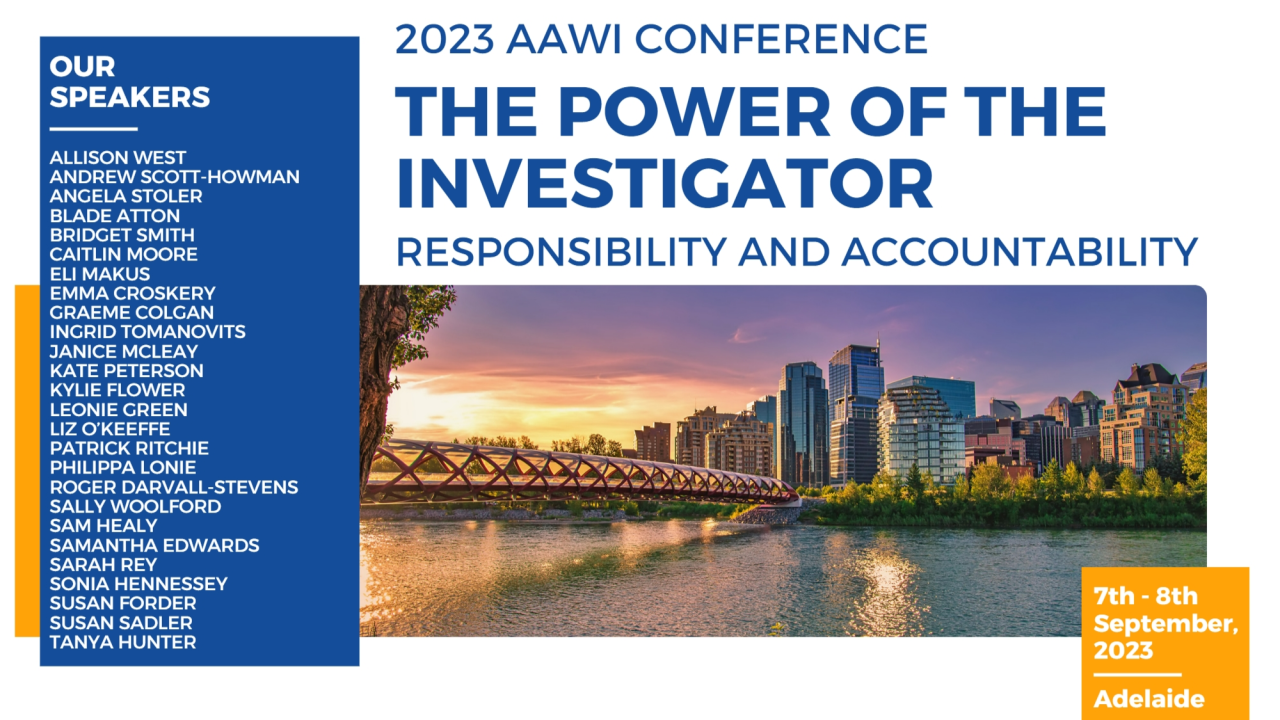Samantha Edwards and Tanya Hunter report back from the Australasian Association of Workplace Investigators (AAWI) conference in Adelaide.
The #MeToo movement has encouraged greater awareness of the pervasive and traumatic nature of sexual harassment and empowered people to share their stories and feel more confident that their organisation will take action. Yet as investigators, and human beings, we appreciate that every matter is unique and that we must bring an open mind to each investigation.
On 8 and 9 September 2023, the Australasian Association of Workplace Investigators (AAWI) held its conference in Adelaide. This year’s theme was “The Power of the Investigator: Responsibility and Accountability”. Our presentation, “Navigating Sexual Harassment Post #Me Too: Unique Challenges for Investigators”,examined and reflected upon the investigator’s role and responsibilities in investigating allegations of sexual harassment.
What are some of the challenges for investigators?
The overall challenge and task for investigators in this space is to conduct a robust and procedurally fair process, while making sure we observe trauma informed principles. These challenges are not unique to investigations relating to sexual harassment, and include the need to:
- Identify relevant evidence;
- Assess credibility of the parties’ evidence, including in the not uncommon situation where no there are no witnesses;
- Assess how certain evidence is probative of the allegations and the weight to be attached to it.
The importance of a trauma informed approach is also not unique to sexual harassment investigations; indeed many trauma informed principles are increasingly recognised as being of general good practice for any investigation. However, in sexual harassment matters, the unique interplay between our different responsibilities as investigators does present some additional challenges, and these are worthy of professional reflection and discussion.
What evidence is relevant?
Sexual harassment is defined in general as having three elements:
- Conduct which is ‘unwelcome’ – viewed as a subjective test as to the complainant’s state of mind;
- Conduct of a sexual nature – this element is generally not controversial and has been broadly interpreted. Recent amendments clarifying that ‘sex based’ harassment is also prescribed conduct also lessen the need to allege or determine whether the conduct is ‘sexual’ as such;
- A reasonable person would have anticipated the possibility that the person harassed would feel offended, humiliated or intimidated – viewed as an objective test.
Our task as investigators is to obtain relevant evidence, meaning evidence which might rationally affect our assessment of a fact in issue or aspect of the allegation. But what evidence might rationally affect matters such as:
- Whether the parties’ evidence is credible about what occurred?
- Whether the conduct was ‘subjectively’ unwelcome?
- What a ‘reasonable person’ would have anticipated in the circumstances?
As we consider the evidence for each element, we must take care not to import value judgement and personal views and assumptions about sexual relations, how people should behave and react in a given context, and to perpetuate unconscious biases and ‘victim blaming’ narratives by an investigator.
It is incumbent upon investigators to recognise this potential, to challenge our own unconscious biases and ensure so far as possible that we assess each matter with an open mind informed, where relevant, by prevailing community standards.
Evolution and expansion of sexual harassment laws
Our understanding of sexual harassment has evolved significantly over time, and this has been reflected in the ongoing evolution of law relating to sexual harassment. Investigators need to ensure they maintain their knowledge of relevant legislation and cases, as this represents the framework within which investigations are conducted. Furthermore, legislative change can represent Parliament’s efforts to reflect and guide community standards and attitudes, which are informative for investigators in this space.
The pace of legal change to sexual harassment laws has most recently been spearheaded by the recommendations arising from Respect@Work Inquiry led by the former Sex Discrimination Commissioner Kate Jenkins which found that current laws were not ‘fit for purpose’. Recent legislative changes establish a legal framework which is people centred and places the responsibility on the employer to make sure the workplace is free from sexual harassment. These changes include:
- The introduction of stop sexual harassment orders;
- A positive duty on employers;
- Clarification regarding protections against ‘sex based harassment’;
- Various other expansions, including protection against harassment arising between employees of different organisations, strengthened protections against harassment conducted through new technologies, and broader protections against sexual harassment for volunteers, contractors, etc in the workplace.
Legislative change will continue to impact sexual harassment investigations, directly and indirectly, and investigators will need to ‘watch this space’ for emerging developments.
Challenges with Contradictory Evidence
One of the challenges we explored was how to decide what evidence (if any) we might consider providing to the complainant for comment in testing key evidence which appears to contradict the complainant’s evidence. Some potential examples of evidence in this category are:
- Evidence undisclosed by the complainant that there was a consensual relationship between the complainant and respondent;
- Evidence as to how the complainant presented/interacted with the respondent shortly after an allegedly distressing incident;
- Evidence which suggests the alleged event is improbably or implausible for some other reason (eg the respondent could not have been at that location at that time)
Given the context, there is a particular risk that the complainant may experience distress in being presented with such evidence. Issues to be balanced include concerns about the potential impact on the complainant’s wellbeing and the potential probative value of the complainant’s response in assessing the credibility of their evidence. These are often not easy matters to navigate, and the complainant should be given information, control and choice about how such information will be given to them, consistent with trauma informed principles.
‘Similar fact’ evidence: multiple complainants
We know from the #MeToo movement that complainants of sexual harassment may find strength in numbers, with an individual motivated to come forward after hearing others’ stories. This might play out in two ways in sexual harassment investigations:
- More than one complainant has come forward with allegations against the same respondent, which are to be investigated simultaneously by the investigator;
- In the course of investigating a complainant’s allegations, evidence arises (eg from a witness) that the respondent has behaved in a similar manner previously with one or more other individuals.
Investigators need to consider whether such evidence is relevant at all, and if so, how much weight it should be given and the implications for procedural fairness. Generally, evidence of this nature is viewed with caution as it can be unfairly prejudicial, but there may be occasions when it is relevant and should be given some weight.
In the first scenario, considerations might include:
- How similar are the complaints? Are they relevantly similar? Does the degree of similarity add to or detract from credibility of their evidence?
- Is there evidence of collaboration, discussion or potential collusion between complainants?
- Where there is evidence of discussion, were the complainants forthcoming and consistent about their discussions?
- Even where the discussions between complainants appear ‘innocent’ (that is, there is no evidence of collusion to either fabricate, exaggerate or provide similar evidence where that is not truthful), does evidence of discussion affect the credibility of the complainants’ evidence?
In the second scenario, evidence which is simply general rumour or vague opinion (eg that the respondent tends to act in a sleazy manner), would not generally be given any weight. However, how should an investigator deal with credible and specific evidence arising during the investigation as to similar past conduct by the respondent? Some potential considerations include:
- How similar is the alleged behaviour?
- Was the alleged behaviour reported and tested at the time?
- Is the respondent aware of the allegation, and have they had an opportunity to respond and comment on it?
- Should this be treated as a new allegation arising and investigated separately?
- Why is this information arising now if not previously reported? Is there any evidence of bias or motive?
Given that the #MeToo movement highlighted how perpetrators of sexual harassment often did engage in patterns of behaviour, as investigators we must not dismiss similar fact evidence, but instead should consider it with caution, keeping the principles of procedural fairness firmly in mind.
As investigators, our duty to impartially gather and assess evidence, and to do so with compassion for all parties, is always at the heart of our practice. Social context and evolving legislation can add to the complexity of investigating sexual harassment, but by acknowledging the complexity in each step of the process, we can ensure that our investigations are fair and robust.


